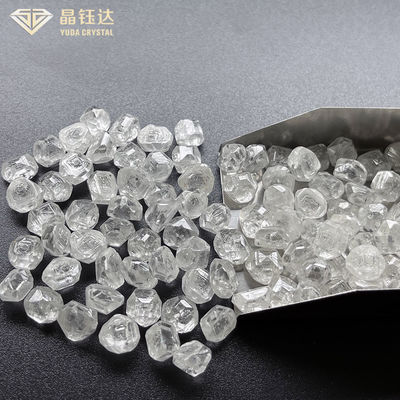3.0-4.0ct DEF Color VS SI Mix Quality Lab Made HPHT Rough Diamonds
Lab Made HPHT Rough Diamonds Description
Laboratory-grown diamonds are grown by simulating the growth environment of natural diamonds through high-temperature and high-pressure methods or chemical meteorological deposition. Their chemical, physical, atomic, and optical properties are the same as natural diamonds; we call them "laboratory-grown diamonds."
There are two processes for laboratory-grown diamond manufacturing-chemical vapor deposition (CVD) and high pressure and high temperature (HPHT), and the rough crystals produced are different in shape.
CVD (Chemical Vapor Deposition) diamond is based on a loose natural diamond stone as the parent stone, using high-purity methane, plus hydrogen, nitrogen and other gases to assist, in a microwave oven at high pressure to make methane the same carbon as diamonds Molecules continue to accumulate on the rough diamond, and after a layer of proliferation, a transparent diamond as large as 10 carats can be formed.
Another commonly used method for cultivating diamonds is "HPHT" (high temperature and high pressure synthesis), which uses iron, nickel and other metal elements as catalysts to simulate the temperature and pressure environment produced by natural diamonds for crystal growth.
High temperature and high pressure (HPHT) diamond planting technology
As the first generation of diamond growth technology, high temperature and high pressure technology can completely simulate the growth process of natural diamonds, reproduce the reaction of the carbon layer on the ground, and convert graphite into diamonds. The growth of HPHT synthetic diamonds takes place in a small chamber of the device, which generates high pressure. In the nacelle, the raw material of diamond powder is dissolved in the molten metal flux and then crystallized on the seed crystal to form a synthetic diamond crystal. The crystallization process takes several weeks to a month or more to form one or more crystals. However, most of the synthetic diamonds produced by this method cannot reach gem level, and are usually used in drilling, cutting, aerospace, electronics, heat exchange and other fields.
At present, the popular high-temperature and high-pressure synthetic diamond equipment in the world mainly includes two side tops (belt, mainly popular in European and American countries), six side tops (unique to China) and strip split ball (Russia) or improved split ball (Gemesis company).
Parameters of Lab Made HPHT Rough Diamonds
| Lab Made HPHT Rough Diamonds Details |
| Brand Name |
Yuda Crystal |
| Name |
Lab Made HPHT Rough Diamonds |
| Diamond Color |
D-F |
| Diamond Clarity |
VS-SI |
| Diamond Carat Weight |
3.0ct - 4.0ct |
| Diamond Cut |
Uncut |
| Technology |
HPHT |
| Size |
5.0-15.0mm |
| Shape |
Raw |
| Application |
For Cutting Lab Grown Loose Diamonds |
| Place Of Origin |
Zhengzhou, China |
| Delivery Time |
1 - 7 Working Days Base on Order Quantity |
| Payment Terms |
100% Payment In Advance |
| Payment Methods |
T/T, PayPal, Western Union, Bank Transfer |
| Shipping way |
DHL, FedEx, SF Express, UPS, EMS, TNT etc |
| M.O.Q |
Negotiable |
| Diamond Type |
Synthetic(lab created) |
| Location |
Zhengzhou, China |
| Treatments Applied |
None |
| Fire Dispersion |
0.044(Same as Natural Diamond) |
| Brilliance Refraction Index |
2.42(Same as Natural Diamond) |
| Relative Density |
3.52(Same as Natural Diamond) |
| Chemical Composition |
Carbon(Same as Natural Diamond) |
| Moh's Hardness |
10(Same as Natural Diamond) |
Lab Made HPHT Rough Diamonds Introduction
Natural diamonds are created by nature and are the result of high temperature and pressure formed over billions of years. The Lab Grown Diamonds are produced in the laboratory, usually in a few weeks. The chemical difference between the two is same.
So how do you distinguish between Lab Grown Diamonds and natural diamonds?
There is no obvious difference between the Lab Grown Diamonds and natural diamonds. Even professional gemologists need special equipment to identify them. By zooming in, professionals will be able to discern subtle contrasts in diamond inclusions grown and mined in the laboratory.
| The Difference Between Lab Diamond And Natural Diamond |
| Properties |
Earth Mined |
Lab Created |
| Guaranteed Conflict-Free |
No |
Yes |
| Hardness (MOHS) |
10 |
10 |
| SP3 Carbon Diamond Bonds (%) |
100% |
100% |
| Internal Crystal Structure |
Face-Centered Cubic |
Face-Centered Cubic |
| Hardness Comparable |
2.42 |
2.42 |
| Relative Diversity |
3.52 |
3.52 |
| Color Diffusion |
0.044 |
0.044 |
| Color |
Various Grades |
K to D grades |
| Price |
$$$$$ |
$$$ |
Lab Made HPHT Rough Diamonds Details


 Your message must be between 20-3,000 characters!
Your message must be between 20-3,000 characters! Please check your E-mail!
Please check your E-mail!  Your message must be between 20-3,000 characters!
Your message must be between 20-3,000 characters! Please check your E-mail!
Please check your E-mail! 





